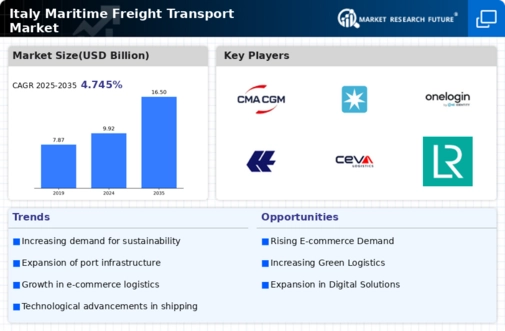Evolving Trade Agreements
The maritime freight-transport market in Italy is experiencing a transformation due to evolving trade agreements. These agreements, particularly those within the European Union, facilitate smoother trade flows and reduce tariffs, thereby enhancing competitiveness. Italy's strategic location in the Mediterranean makes it a pivotal hub for trade between Europe, Africa, and the Middle East. As a result, the volume of goods transported via maritime routes is projected to increase by approximately 5% annually. This growth is likely to stimulate investments in shipping and logistics, further bolstering the maritime freight-transport market.
Investment in Port Modernization
Investment in port modernization is a critical driver for the maritime freight-transport market in Italy. The Italian government, alongside private stakeholders, is allocating substantial funds to upgrade port infrastructure. This includes expanding capacity, improving connectivity, and enhancing facilities to accommodate larger vessels. Recent reports indicate that investments could reach €1 billion by 2027. Such modernization efforts are expected to increase operational efficiency and attract more shipping lines, thereby boosting the overall competitiveness of the maritime freight-transport market.
Technological Advancements in Shipping
Technological advancements are reshaping the maritime freight-transport market in Italy. Innovations such as automation, artificial intelligence, and blockchain are streamlining operations, enhancing efficiency, and reducing costs. For instance, the adoption of automated container handling systems in major Italian ports has led to a 20% reduction in turnaround times. Furthermore, the integration of blockchain technology is improving transparency and traceability in supply chains, which is crucial for compliance with international regulations. These technological shifts are expected to drive growth in the maritime freight-transport market, attracting more stakeholders.
Environmental Regulations and Compliance
The maritime freight-transport market in Italy is increasingly influenced by stringent environmental regulations. The European Union's Green Deal aims to reduce greenhouse gas emissions from shipping by 55% by 2030. Compliance with these regulations necessitates investments in cleaner technologies and fuels, such as LNG and hydrogen. Italian shipping companies are likely to face rising operational costs as they adapt to these standards. However, this shift towards sustainability may also open new market opportunities, as environmentally conscious consumers and businesses seek greener logistics solutions.
Increased Demand for E-commerce Logistics
The rise of e-commerce is significantly impacting the maritime freight-transport market in Italy. As online shopping continues to grow, the demand for efficient logistics solutions is escalating. This trend is expected to drive a 10% increase in container shipping volumes over the next few years. Italian ports are adapting to this demand by enhancing their capabilities to handle smaller, more frequent shipments. Consequently, the maritime freight-transport market is likely to see a shift towards more agile and responsive logistics networks, catering to the needs of e-commerce businesses.



















Leave a Comment